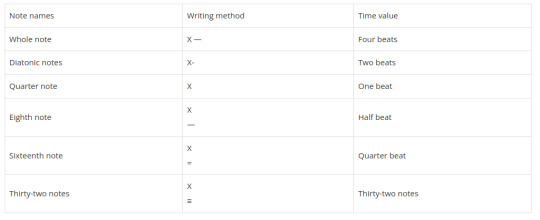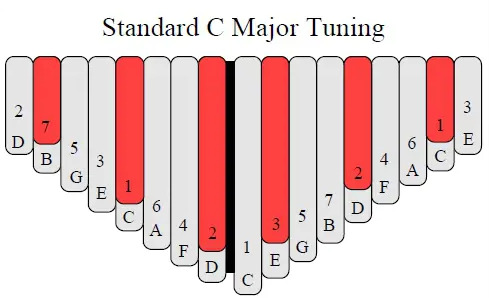Text
How to read numeric sample notation of kalimba?
How to read numeric sample notation of kalimba? 7 musical notation is a simple notation. There are two kinds of simple notation: alphabetic simple notation and numeric simple notation. The numeric simple notation is based on the chanting method, using 1, 2, 3, 4, 5, 6, 7 to represent the seven basic levels in the scale, reading the sounds do, re, mi, fa, sol, la, si, and 0 to indicate rest.
Basic elements
Tone height: Any piece of music is composed of high and low tones, and the shorter the key, the higher the tone from the thumb piano (also called kalimba). In the case of a digital score, there is a “.” directly above or below the numbers. symbols, above them means high notes and below them means low notes.
The length of the tone: In addition to the height of the tone, another important factor is the length of the tone. The high or low and the length of the tone are marked to determine the tune from another tune. The principle is expressed as the duration of the sound.
Basics
Writing: 1 2 3 4 5 6 7

To mark a higher or lower note, a dot is added above or below the number. In the short form, without a dot, it is called an alto; with a dot above it, it is called a treble; with two dots, it is called a double treble. The 17-note kalimba thumb piano in C major does not have a bass, so if you have a song with a bass note, you can move the whole song an octave higher.
Augmented and diminished timelines
The length of a note is indicated by adding a short horizontal line, a dot, a sustained line, and a note number to the basic notes in the score.
There are two ways to use the short horizontal line: the short horizontal line written to the right of the fundamental note is called the augmentation line. The more augmented lines there are, the longer the duration of the note.
The basic note without an incremental line is called a quarter note, and each additional incremental line extends the time of a quarter note.
The short horizontal lines written below the fundamental notes are called decrement lines. The more decrement lines there are, the shorter the note. Each additional decrement line means that the note is shortened by half the length of the original note.
The dot written to the right of the note is called a dot, which extends the time value of the preceding note by half.
The symbols that temporarily change the pitch of a note are called temporary change marks, mainly the ascending and descending signs. The ascending sign is written at the top left of the note and indicates that the note has raised a semitone, e.g. #1 means that 1 is raised a semitone, which requires special tuning on the thumb piano. The descending sign is written at the top left of the note and means that the note is lowered by a semitone, e.g. b3 means lowering 3 by a semitone, which also requires tuning on the thumb piano.
Note length
The notes are divided into whole notes, dichotomous notes, quarter notes, eighth notes, sixteenth notes, and so on. The most important of these notes is the quarter note, which is a basic reference length, i.e. a quarter note is a beat. There is no limit to the length of a beat, it can be 1 second or 2 seconds or half a second. If one beat is the length of one second, then two beats are two seconds; if one beat is set to half a second, two beats is the length of one second. Once this basic one-beat is set, it is relatively easy to set symbols that are longer or shorter than one beat.

Rhythm

The method is hand down is half a beat, palm up is half a beat, one up is a beat
Extension line
In thumb piano notation, the arcs are marked on the top of the notes and are called sustain lines.
The sustain line: If it is the same note, only the first note is played, and the second note keeps its time value.
0 notes
Text
How to tune a kalimba?
Today we learn how to tune a kalimba, Keeping your Kalimba instrument in good condition and well tuned is important as it helps you improve the sound and condition of your Kalimba. This will improve your skills with your instrument.
Tuning a Kalimba entails individually tuning each tine to a certain pitch so that the notes sound exactly as anticipated. The precisely tuned tines, when played together, form a musical scale or portion of one. This is the tuning of the Kalimba, and how it sounds when the notes are played simultaneously.
In this post, we’ll look at both elements of Kalimba tuning. We’ll go over how to tune the various keys on the instrument. Once you’ve worked it out, your Thumb Piano will be considerably more versatile than you could have imagined because you’ll be able to retune the kalimba to other scales, or ‘Tunings,’ as needed.
Tuning a Kalimba

What notes to Tune the Kalimba keys to
Let’s forget about tuning to various scales right now and concentrate on the scale that your Kalimba has arrived at. Quite often new kalimbas are tuned to the scale of C and the keys are marked with the letters of each note.
What notes are on a Kalimba?

Regularly Check the tuning of your Kalimba
Whether or not you think your Kalimba is out of tune, it’s a good idea to check the tuning of each tine once a week. One or two of the most often played tines may be slightly out of tune, but not enough for your ear to detect. If you leave for an extended period of time, more notes will be off, and your KalImba will start to sound awful.
How to check each note is in tune?
Using a tuning tool to check the correctness of the tuning for each key on your Kalimba instrument is the simplest method. This can include electrical tuners or a mobile phone tuning application.
It’s totally up to you which tuning tool you use. There are some good free tuning applications for iOS and Android, but it’s worth paying a few dollars to avoid being interrupted by commercials when tuning your kalimba.
Tuning apps for Kalimba
Using a basic guitar tuning application will provide you with everything you need to check your Kalimba’s tuning and lead you through the modifications you’ll need to make to get it back in tune or retune the thumb piano to a new scale.
There are various applications available for both iOS and Android cellphones, here is a list of some of them:
ANDROID Apps
GStrings is undoubtedly one of the most widely used tuning applications on any mobile device. Pop-up advertising is included in this free software from the PlayStore, which can be a nuisance, but that is the price of a free app.
IOS Apps
InsTuner is one of a few tuning apps on IOS. It is popular for a lot of people, but a lot of people do not like it either.
How to tune a kalimba?
Now that we have the kalimba and the tools to detect whether or not each tine is in tune, we can adjust those that are out of tune. The tuning hammer is used to do this.
What is the Kalimba hammer for?
You’ve been looking online for Kalimbas and are considering purchasing one; you see it comes with a convenient travel box and a hammer. But what is the purpose of the hammer?
The kalimba hammer is a thumb piano tuning tool made of metal with a wooden handle that is used to tune the kalimba keys with little taps, changing the distance between the front of the tine and the bridge, changing the pitch of the tines and the notes played.
This is a delicate piece of equipment for tuning the keys on your Kalimba, but it’s also sturdy enough that you only need to hit the tines lightly.
Where to get a Kalimba Tuning Hammer?
Many Kalimbas come with a case that includes a tuning hammer, so you’re likely to have one already.
If you don’t have one, you’ll note that the head is fairly small and that it is a little more sensitive than your garage hammer.
Which way do I need to move the tines?
You’ve undoubtedly figured out that the lower the note, the shorter the tine following the bridge, and vice versa.
So, very easy:
Hammer up, to higher the note
Hammer down to lower the note
When tuning a Kalimba key, even the slightest movement up or down the bridge affects the pitch of the note, removing the need for enormous hammer blows.
Depending on the change in tine note that you wish to make, the hammer is used to tap the top or bottom of the tine.
It just takes a few clicks to change the pitch, so don’t go crazy and double-check the pitch with the tuning app after every couple of presses.
Kalimba Tuning Scales
Kalimbas come in a variety of tine counts, ranging from 7 to 17, with the most popular and standard instruments giving 15 tines on the Hugh Tracey Alto, or 17 tines on many other brands on the market, and tuning to G Major or C.
Can you tune a kalimba to a different key?
It’s simple to tune a kalimba to a different key than it’s currently tuned to. Simply change each tine to the particular note necessary for the new key and scale you intend to play using a tuning hammer and tuning software.
The reality is that unless a kalimba is specially ordered and adjusted, it is tuned to normal scales, allowing you to learn and play many well-known songs.’
Tuning a Kalimba to a different scale and exploring the universe of new possibilities that this affords is where things can get very exciting and help you produce creative music.

5 notes
·
View notes